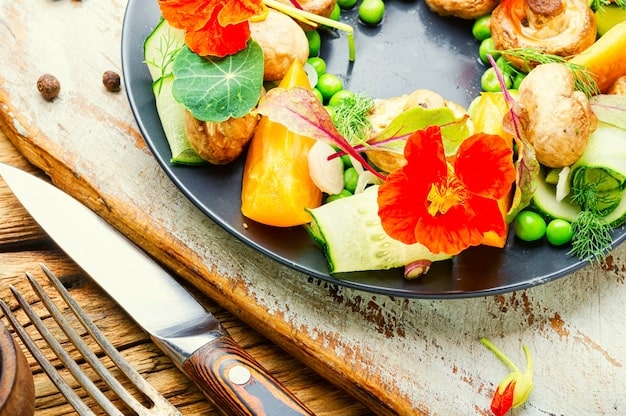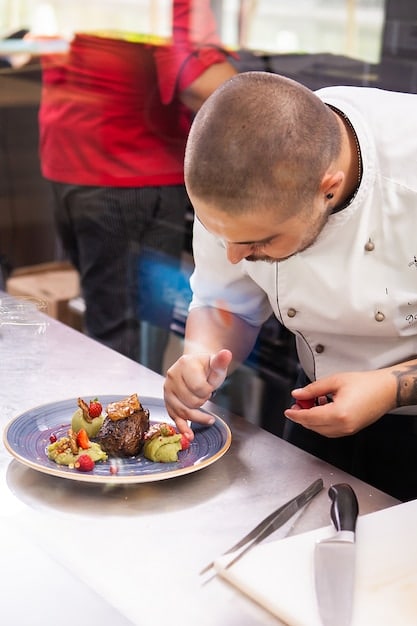The Future of American Cuisine: Trends and Cultural Shifts

The Future of American Cuisine: Exploring Emerging Food Trends and Cultural Influences involves a deeper look into the evolution of culinary preferences, highlighting the impact of cultural fusion, technological innovations, and a growing consciousness towards sustainability and health.
The shifting landscape of American gastronomy reveals a fascinating interplay of tradition and innovation. Exploring The Future of American Cuisine: Exploring Emerging Food Trends and Cultural Influences offers a glimpse into how cultural diversity, technological advancements, and a renewed focus on sustainability are reshaping what we eat and how we experience food.
The rise of fusion cuisine
American cuisine, traditionally seen as a melting pot, is increasingly characterized by fusion cuisine. This involves blending culinary traditions from different cultures to create unique and innovative dishes. The trend reflects America’s diverse population and the growing openness to trying new and exciting flavors.
Fusion cuisine is not just about mixing ingredients; it’s about creating a completely new culinary experience. Chefs are now experimenting with techniques and ingredients from around the world, resulting in inventive dishes that showcase the best of multiple traditions.
The Impact of Asian Flavors
One of the most significant influences on American fusion cuisine is Asian flavors. Ingredients like soy sauce, ginger, and sesame oil have become staples in many American kitchens, and chefs are using them in creative ways to enhance traditional dishes.
Latin American Culinary Contributions
Latin American cuisine has also made a substantial impact, with ingredients like cilantro, avocados, and various chilies finding their way into mainstream American cooking. The vibrant and bold flavors of Latin America are adding a new dimension to American dishes.
- Korean Tacos: A blend of Korean barbecue and Mexican street food.
- Sushi Burritos: Combining Japanese sushi with Mexican burrito formats.
- Indian Pizza: Featuring a mix of traditional Indian spices and pizza toppings.
The rise of fusion cuisine signifies a more inclusive and adventurous approach to food in America. Consumers are increasingly seeking out these hybrid culinary creations, driving chefs to push the boundaries of traditional cooking.

Technological Innovations in Food
Technology is playing an increasingly significant role in shaping the future of American cuisine. From advanced cooking equipment to innovative food delivery systems, technology is transforming the way we produce, prepare, and consume food.
These innovations are not just about convenience; they are also about improving efficiency, sustainability, and the overall dining experience.
Advanced Cooking Techniques
Modern cooking techniques such as sous vide and molecular gastronomy are becoming more accessible to both professional chefs and home cooks. These methods allow for precise control over cooking temperatures and textures, resulting in consistently high-quality dishes.
- Sous Vide: A method of cooking food in vacuum-sealed bags in a water bath at a precise temperature.
- 3D Food Printing: Creating food items using specialized printers that layer ingredients based on digital designs.
- Robotic Chefs: Automated cooking systems that can prepare meals with minimal human intervention.
The digital dining experience
Technology has revolutionized the dining experience, especially with the emergence of online ordering and delivery services. These platforms enable customers to quickly browse menus, place orders, and have food delivered to their doorsteps with ease.
Advancements in kitchen technology, like smart ovens and automated cooking systems, streamline operations, reduce waste, and ensure consistency in food preparation. These tools enable chefs to focus on creativity and customer satisfaction.

The sustainability movement
Sustainability is rapidly becoming a core principle in the American culinary scene. Consumers are increasingly aware of the environmental and social impact of their food choices, leading to a greater demand for sustainable and ethically sourced ingredients.
This movement encompasses various aspects, including reducing food waste, sourcing local and seasonal ingredients, and supporting environmentally friendly farming practices.
Local and Seasonal Sourcing
Locally sourced ingredients reduce the carbon footprint associated with long-distance transportation. Seasonal eating ensures that produce is consumed at its peak flavor and nutritional value, while also supporting local farmers and economies.
Minimizing Food Waste
Reducing food waste is a critical component of sustainable cuisine. Restaurants and home cooks are adopting strategies such as composting, using food scraps in creative dishes, and implementing inventory management systems to minimize waste.
- Composting Programs: Turning food waste into nutrient-rich soil for gardening and agriculture.
- Farm-to-Table Initiatives: Restaurants partnering with local farms to source fresh, seasonal ingredients.
- Sustainable Seafood: Choosing seafood from responsibly managed fisheries to protect marine ecosystems.
Chefs are also embracing practices like whole animal butchery and root-to-stem cooking, which involve using every part of an ingredient to minimize waste. These efforts not only reduce environmental impact but also promote creativity in the kitchen.
Health and wellness trends
Health and wellness trends are significantly impacting the future of American cuisine. As consumers become more health-conscious, they are seeking out foods that are not only delicious but also nutritious and beneficial for their well-being.
This shift is driving innovation in the food industry, with a focus on ingredients and cooking methods that promote health.
The Rise of Plant-Based Diets
Plant-based diets are gaining popularity in America, driven by concerns about health, animal welfare, and environmental sustainability. Chefs are responding by creating innovative and flavorful plant-based dishes that appeal to both vegetarians and meat-eaters.
Focus on Nutrient-Dense Ingredients
Consumers are increasingly interested in nutrient-dense foods that provide a high concentration of vitamins, minerals, and antioxidants. Ingredients like quinoa, kale, and avocados are becoming staples in American diets.
- Gluten-Free Options: Providing alternatives for those with gluten sensitivities or preferences.
- Low-Sugar Alternatives: Using natural sweeteners and reducing overall sugar content in dishes.
- Functional Foods: Incorporating ingredients known for their health benefits, such as probiotics and omega-3 fatty acids.
This focus on health and wellness is not just a passing fad; it represents a fundamental shift in how Americans view food. As people become more informed about the connection between diet and health, they are making more conscious choices about what they eat.
The Influence of Social Media
Social media has revolutionized the way people discover and share food experiences. Platforms like Instagram, TikTok, and YouTube have become powerful tools for chefs and restaurants to showcase their creations and engage with customers.
This digital influence extends beyond marketing; it also shapes culinary trends and drives innovation in the food industry.
Food as a Visual Experience
Social media has elevated the importance of food presentation. Dishes are now designed not only to taste good but also to look visually appealing. Chefs are paying more attention to plating techniques, color combinations, and overall aesthetics to create Instagram-worthy dishes.
The Power of Food Influencers
Food influencers play a significant role in shaping culinary trends. Their recommendations and reviews can have a substantial impact on a restaurant’s popularity and a chef’s reputation.
- Online Cooking Tutorials: Providing step-by-step instructions for preparing dishes at home.
- Restaurant Reviews: Sharing honest and detailed feedback about dining experiences.
- Food Photography: Showcasing visually stunning images of food to inspire and entice viewers.
Social media enables consumers to stay informed about new culinary trends and share their own food experiences with others. This constant exchange of information and inspiration fosters creativity and innovation in the food industry.
The cultural renaissance of regional American cuisine
While global influences are prominent, there’s a growing appreciation for regional American cuisine celebrating local ingredients, cooking methods, and culinary heritage unique to specific areas of the United States.
This movement is driven by a desire to preserve and promote the diverse culinary traditions of the country, countering the homogenization of food that can occur with globalization.
Embracing Local and Regional Specialties
Chefs are digging deeper into their regional roots, highlighting ingredients and dishes that define their local food culture. This involves working closely with local farmers, producers, and artisans to source authentic and high-quality ingredients.
Preserving Culinary Heritage
Many chefs are committed to preserving traditional cooking methods and recipes passed down through generations. This includes techniques like smoking, curing, and pickling, as well as dishes that reflect the unique culinary history of a region.
- Lowcountry Cuisine: Featuring dishes like shrimp and grits, she-crab soup, and collard greens.
- Pacific Northwest Cuisine: Emphasizing fresh seafood, wild mushrooms, and locally grown berries.
- Midwestern Cuisine: Offering hearty fare such as corn on the cob, deep-dish pizza, and cheese curds.
This cultural renaissance of regional American cuisine reflects a broader trend of valuing authenticity and uniqueness. Consumers are increasingly interested in exploring the distinct flavors and culinary traditions that make each region of America special.
| Key Point | Brief Description |
|---|---|
| 🌍 Fusion Cuisine | Blending diverse culinary traditions for novel dining experiences. |
| 🤖 Tech Innovations | Using tech to improve efficiency and sustainability in food. |
| 🌱 Sustainability | Focusing on local sourcing, less waste, and eco-friendly practices in the food industry. |
| 💪 Health Trends | Growing interest in plant-based diets and nutrient-rich foods for better health. |
FAQ
▼
Examples include Korean tacos, sushi burritos, and Indian pizza, which blend flavors and techniques from different culinary traditions to create unique dishes.
▼
Technology enhances cooking with techniques like sous vide, improves kitchen efficiency, and transforms dining with online ordering and innovative delivery systems.
▼
Sustainability addresses environmental and social concerns by promoting local sourcing, reducing food waste, and supporting ethical and eco-friendly farming practices.
▼
Trends include the rise of plant-based diets, a focus on nutrient-dense ingredients, and the demand for gluten-free and low-sugar options to cater to health-conscious consumers.
▼
Social media elevates food presentation, allows influencers to drive culinary trends, and enables consumers to discover and share food experiences, fostering innovation in the industry.
Conclusion
In conclusion, the Future of American Cuisine: Exploring Emerging Food Trends and Cultural Influences reveals a dynamic and multifaceted culinary landscape shaped by fusion cuisine, technological innovations, sustainability efforts, health and wellness trends, the influence of social media, and the cultural renaissance of regional American cuisine. These elements collectively contribute to a vibrant and evolving food culture that promises exciting developments in the years to come.





